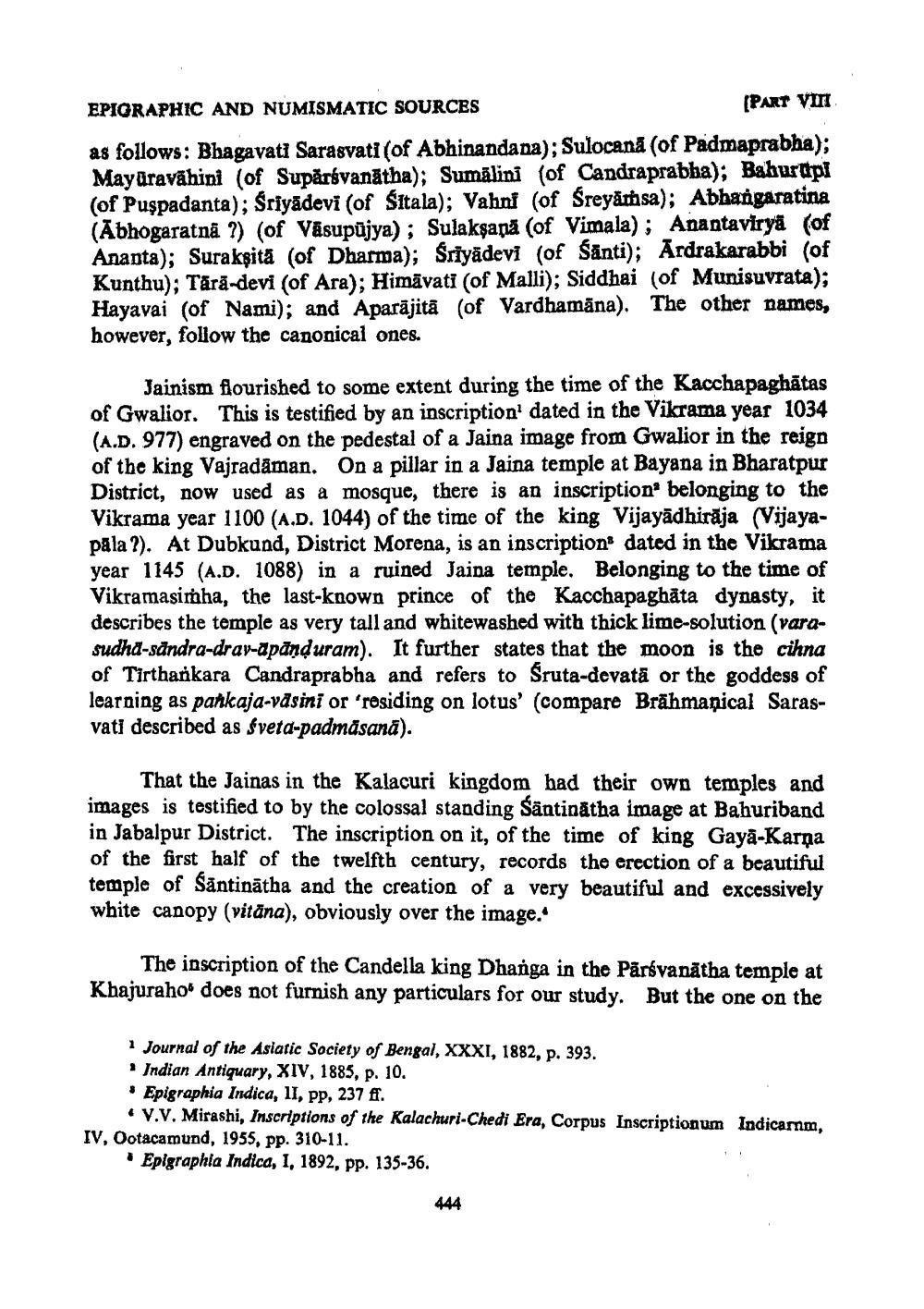________________
EPIGRAPHIC AND NUMISMATIC SOURCES
[PART VIII
as follows: Bhagavati Sarasvati (of Abhinandana); Sulocana (of Padmaprabha); Mayuravahini (of Supärsvanatha); Sumalini (of Candraprabha); Bahurupi (of Puspadanta); Sriyadevi (of Sitala); Vahni (of Śreyamsa); Abhangaratina (Abhogaratna ?) (of Vasupujya); Sulaksana (of Vimala); Anantaviryä (of Ananta); Surakṣitā (of Dharma); Sriyadevi (of Santi); Ardrakarabbi (of Kunthu); Tärä-devi (of Ara); Himavati (of Malli); Siddhai (of Munisuvrata); Hayavai (of Nami); and Aparajita (of Vardhamäna). The other names, however, follow the canonical ones.
Jainism flourished to some extent during the time of the Kacchapaghātas of Gwalior. This is testified by an inscription' dated in the Vikrama year 1034 (A.D. 977) engraved on the pedestal of a Jaina image from Gwalior in the reign of the king Vajradaman. On a pillar in a Jaina temple at Bayana in Bharatpur District, now used as a mosque, there is an inscription" belonging to the Vikrama year 1100 (A.D. 1044) of the time of the king Vijayādhiraja (Vijayapala?). At Dubkund, District Morena, is an inscription dated in the Vikrama year 1145 (A.D. 1088) in a ruined Jaina temple. Belonging to the time of Vikramasimha, the last-known prince of the Kacchapaghata dynasty, it describes the temple as very tall and whitewashed with thick lime-solution (varasudha-sandra-drav-apaṇḍuram). It further states that the moon is the cihna of Tirthankara Candraprabha and refers to Śruta-devata or the goddess of learning as pankaja-vāsini or 'residing on lotus' (compare Brahmanical Sarasvati described as sveta-padmāsanā).
That the Jainas in the Kalacuri kingdom had their own temples and images is testified to by the colossal standing Santinätha image at Bahuriband in Jabalpur District. The inscription on it, of the time of king Gaya-Karņa of the first half of the twelfth century, records the erection of a beautiful temple of Santinatha and the creation of a very beautiful and excessively white canopy (vitäna), obviously over the image.
The inscription of the Candella king Dhanga in the Parsvanatha temple at Khajuraho does not furnish any particulars for our study. But the one on the
1 Journal of the Asiatic Society of Bengal, XXXI, 1882, p. 393.
'Indian Antiquary, XIV, 1885, p. 10.
⚫ Epigraphia Indica, 11, pp, 237 ff.
V.V. Mirashi, Inscriptions of the Kalachuri-Chedi Era, Corpus Inscriptionum Indicarnm, IV, Ootacamund, 1955, pp. 310-11.
⚫ Epigraphia Indica, I, 1892, pp. 135-36.
444




